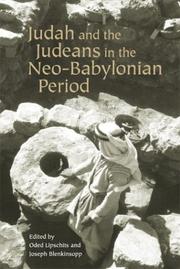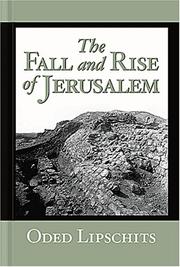| Listing 1 - 3 of 3 |
Sort by
|


ISBN: 1575065401 9781575065403 1575060736 9781575060736 Year: 2021 Publisher: University Park, PA
Abstract | Keywords | Export | Availability | Bookmark
 Loading...
Loading...Choose an application
- Reference Manager
- EndNote
- RefWorks (Direct export to RefWorks)
This volume is the outcome of an international conference held at Tel Aviv University, May 29-31, 2001. The idea for the conference germinated at the fifth Transeuphratene colloquy in Paris in March 2000. The Tel Aviv conference was organized in order to encourage investigation into the obscure five or six decades preceding the Persian conquests in the latter part of the 6th century. The essays here are organized in 5 parts: (1) The Myth of the Empty Land Revisited; (2) Cult, Priesthood, and Temple; (3) Military and Governmental Aspects; (4) Archaeological Perspectives on the 6th Century B.C.E.; and (5) Exiles and Foreigners in Egypt and Babylonia.Contributors: H. M. Barstad, B. Oded, L. S. Fried, S. Japhet, J. Blenkinsopp, G. N. Knoppers, Y. Amit, D. Edelman, Y. Hoffman, R. H. Sack, D. Vanderhooft, J. W. Betlyon, A. Lemaire, C. E. Carter, O. Lipschits, A. Zertal, J. R. Zorn, B. Porten, and R. Zadok.
Jews --- Judaism --- Hebrews --- Israelites --- Jewish people --- Jewry --- Judaic people --- Judaists --- Ethnology --- Religious adherents --- Semites --- History --- Historiography --- Bible. --- Antico Testamento --- Hebrew Bible --- Hebrew Scriptures --- Kitve-ḳodesh --- Miḳra --- Old Testament --- Palaia Diathēkē --- Pentateuch, Prophets, and Hagiographa --- Sean-Tiomna --- Stary Testament --- Tanakh --- Tawrāt --- Torah, Neviʼim, Ketuvim --- Torah, Neviʼim u-Khetuvim --- Velho Testamento --- Criticism, interpretation, etc. --- Palestine --- Babylonia --- Vavilonii︠a︡ --- Bavel --- Bābil --- Babylonien --- Sumer --- Holy Land --- Antiquities --- Relations --- Babylonisches Exil. --- Juda --- Babylonisches Exil --- International relations. --- Antiquities. --- Archaeological specimens --- Artefacts (Antiquities) --- Artifacts (Antiquities) --- Specimens, Archaeological --- Material culture --- Archaeology --- Coexistence --- Foreign affairs --- Foreign policy --- Foreign relations --- Global governance --- Interdependence of nations --- International affairs --- Peaceful coexistence --- World order --- National security --- Sovereignty --- World politics --- Religions --- Post-exilic period (Judaism) --- Religion --- Bible --- Juda. --- Palästina. --- Judäa. --- Babylonien. --- Middle East --- Orient --- Asia, South West --- Asia, Southwest --- Asia, West --- Asia, Western --- East (Middle East) --- Eastern Mediterranean --- Fertile Crescent --- Levant --- Mediterranean Region, Eastern --- Mideast --- Near East --- Northern Tier (Middle East) --- South West Asia --- Southwest Asia --- West Asia --- Western Asia --- Israel --- Eretz Israel --- Erets Israel --- Erets Yiśraʼel --- Filasṭīn --- Palesṭin --- Erez Jisrael --- Paleśtinah --- Memshelet Paleśtinah --- Palestina --- Palästina --- Falastīn --- Hellenistic Judaism --- Judaism, Hellenistic --- Babylonische Gefangenschaft --- Exil --- Juden --- v597-v538 --- Vavilonii͡ --- Babylonisches Reich --- Akkad --- Xwla --- Xweda --- Ajuda --- Feda --- Fera --- Fida --- Houeda --- Hweda --- Hwida --- Ouida --- Ouidah --- Peda --- Phela --- Phera --- Whydah --- Xwela-Gbe --- Benin --- Togo
Book

ISBN: 1575063573 9781575063577 1575063565 9781575063560 9781575063560 Year: 2021 Publisher: University Park, PA
Abstract | Keywords | Export | Availability | Bookmark
 Loading...
Loading...Choose an application
- Reference Manager
- EndNote
- RefWorks (Direct export to RefWorks)
The 22 essays in this new and comprehensive study explore how notions of covenant, especially the Sinaitic covenant, flourished during the Neo-Babylonian, Persian, and early Hellenistic periods. Following the upheaval of the Davidic monarchy, the temple’s destruction, the disenfranchisement of the Jerusalem priesthood, the deportation of Judeans to other lands, the struggles of Judeans who remained in the land, and the limited returns of some Judean groups from exile, the covenant motif proved to be an increasingly influential symbol in Judean intellectual life. The contributors to this volume, drawn from many different countries including Canada, Germany, Israel, South Africa, Switzerland, and the United States, document how Judean writers working within historiographic, Levitical, prophetic, priestly, and sapiential circles creatively reworked older notions of covenant to invent a new way of understanding this idea. These writers examine how new conceptions of the covenant made between YHWH and Israel at Mt. Sinai play a significant role in the process of early Jewish identity formation. Others focus on how transformations in the Abrahamic, Davidic, and Priestly covenants responded to cultural changes within Judean society, both in the homeland and in the diaspora. Cumulatively, the studies of biblical writings, from Genesis to Chronicles, demonstrate how Jewish literature in this period developed a striking diversity of ideas related to covenantal themes.
Covenant theology --- Jews --- Hebrews --- Israelites --- Jewish people --- Jewry --- Judaic people --- Judaists --- Ethnology --- Religious adherents --- Semites --- Judaism --- Biblical teaching. --- History --- 933.23 --- 933.3 --- 222 --- 222.1 --- 222.2 --- 224 --- 223.7 --- 222.7 --- 933.3 Geschiedenis van het Joodse volk: Tweede Tempelperiode--(538 v.Chr.-70 n.Chr.) --- Geschiedenis van het Joodse volk: Tweede Tempelperiode--(538 v.Chr.-70 n.Chr.) --- 933.23 Geschiedenis van het Joodse volk: ballingschap--(587-538 v.Chr.) --- Geschiedenis van het Joodse volk: ballingschap--(587-538 v.Chr.) --- Biblical teaching --- History&delete& --- Historische boeken van het Oude Testament --- Octateuch. Heptateuch. Hexateuch. Pentateuch. Boeken van Mozes --- Genesis --- Profetische boeken van het Oude Testament --- Wijsheid. Wijsheid van Jesus Sirach (Ecclesiasticus) --- Kronieken. Ezra. Nehemia --- Jews in Babylonian captivity (598 - 515 B.C.) --- Babylonisches Exil --- Bund Gottes --- Jews. --- Jewish question --- Bund --- Theologie des Bundes --- Gottesbund --- Bundestheologie --- Heilsgeschichte --- Föderaltheologie --- Babylonische Gefangenschaft --- Exil --- Juden --- Israel --- Babylonien --- v597-v538 --- Föderaltheologie

ISBN: 1575062976 1575065533 9781575065533 9781575060958 1575060957 Year: 2021 Publisher: University Park, PA
Abstract | Keywords | Export | Availability | Bookmark
 Loading...
Loading...Choose an application
- Reference Manager
- EndNote
- RefWorks (Direct export to RefWorks)
The period of the demise of the kingdom of Judah at the end of the 6th century B.C.E., the fall of Jerusalem to the Babylonians, the exile of the elite to Babylon, and the reshaping of the territory of the new province of Judah, culminating at the end of the century with the first return of exiles-all have been subjects of intense scrutiny during the last decade. Lipschits takes into account the biblical textual evidence, the results of archaeological research, and the reports of Babylonian and Egyptian sources and provides a comprehensive survey and analysis of the evidence for the history of this 100-year-long era. He provides a lucid historical survey that will, no doubt, become the baseline for all future studies of this era.
Jews --- Babylonian captivity, Jewish --- Babylonian exile, Jewish --- History --- Bible. --- Antico Testamento --- Hebrew Bible --- Hebrew Scriptures --- Kitve-ḳodesh --- Miḳra --- Old Testament --- Palaia Diathēkē --- Pentateuch, Prophets, and Hagiographa --- Sean-Tiomna --- Stary Testament --- Tanakh --- Tawrāt --- Torah, Neviʼim, Ketuvim --- Torah, Neviʼim u-Khetuvim --- Velho Testamento --- Criticism, interpretation, etc. --- Judaea (Region) --- Palestine --- Erets Yehudah (Region) --- Ereẓ Yehudah (Region) --- Judah, Land of (Region) --- Judea (Region) --- Land of Judah (Region) --- Yahūdhā (Region) --- Yehuda (Region) --- History. --- Antiquities. --- 902 <33 JERUSALEM> --- 933 JERUSALEM --- 902 <33 JERUSALEM> Archeologie--Oud-Palestina. Judea--JERUSALEM --- Archeologie--Oud-Palestina. Judea--JERUSALEM --- 933 JERUSALEM Geschiedenis van Palestina en het Joodse volk--JERUSALEM --- Geschiedenis van Palestina en het Joodse volk--JERUSALEM --- Babylonisches Exil --- Antiquities --- Archaeological specimens --- Artefacts (Antiquities) --- Artifacts (Antiquities) --- Specimens, Archaeological --- Material culture --- Archaeology --- Hebrews --- Israelites --- Jewish people --- Jewry --- Judaic people --- Judaists --- Ethnology --- Religious adherents --- Semites --- Judaism --- Jerusalem, ... --- Gesamtverband Jüdischer Hochschüler Judäa --- Judäa --- Gesamtverband Jüdischer Hochschüler Österreichs Judäa --- Babylonien --- Palästina --- Middle East --- Israel --- Eretz Israel --- Erets Israel --- Erets Yiśraʼel --- Filasṭīn --- Palesṭin --- Erez Jisrael --- Paleśtinah --- Memshelet Paleśtinah --- Palestina --- Falastīn --- Sumer --- Vavilonii︠a︡ --- Bavel --- Bābil --- Orient --- Asia, South West --- Asia, Southwest --- Asia, West --- Asia, Western --- East (Middle East) --- Eastern Mediterranean --- Fertile Crescent --- Levant --- Mediterranean Region, Eastern --- Mideast --- Near East --- Northern Tier (Middle East) --- South West Asia --- Southwest Asia --- West Asia --- Western Asia --- Palaia Diathēk --- Jewish question --- Babylonische Gefangenschaft --- Exil --- Juden --- v597-v538 --- Land of --- Filasṭīn --- Falasṭīn --- Pālēśtīnā --- Palaestina --- ʾĒrēts Yiśrāʾel --- Eretz Yisrael --- Erez Israel --- Heiliges Land --- Gelobtes Land --- Babylonisches Reich --- Akkad
| Listing 1 - 3 of 3 |
Sort by
|

 Search
Search Feedback
Feedback About UniCat
About UniCat  Help
Help News
News